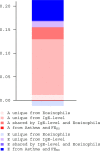Genetic effects of allergen-specific IgE levels on exhaled nitric oxide in schoolchildren with asthma: The STOPPA twin study
- PMID: 33349970
- PMCID: PMC8248142
- DOI: 10.1111/pai.13438
Genetic effects of allergen-specific IgE levels on exhaled nitric oxide in schoolchildren with asthma: The STOPPA twin study
Abstract
Background: Exhaled nitric oxide and blood eosinophils are clinical asthma T-helper type 2 markers in use. Immunoglobulin E (IgE) is often involved in the inflammation associated with atopic asthma. The effect of both blood eosinophils and allergen-specific IgE on exhaled nitric oxide levels is not completely understood. Twin-design studies can improve understanding of the underlying contribution of genetically and/or environmentally driven inflammation markers in asthma. Our aim was to disentangle the covariance between asthma and exhaled nitric oxide into genetic and environmental contributions that can account for inflammation markers in a paediatric population.
Methods: This population-based, cross-sectional twin study enrolled 612 monozygotic (MZ) and same-sex dizygotic (DZ) schoolchildren. Multivariate structural equation modelling was utilized to separate the covariance between asthma and exhaled nitric oxide into genetic and/or environmental effects, taking allergen-specific IgE level and blood eosinophil count into account while controlling for confounding factors.
Results: The cross-twin/cross-trait correlations had a higher magnitude in the MZ twins than in the DZ twins, indicating that genes affect the association. The likelihood ratio test for model fitting resulted in the AE model (ie additive genetic effects, A, and non-shared environmental effects, E) as the most parsimonious. A majority, 73%, of the phenotypic correlation between asthma and exhaled nitric oxide, r = .19 (0.05-0.33), was attributable to genetic effects which mainly was due to the allergen-specific IgE level.
Conclusions: This study indicates that the association between asthma and exhaled nitric oxide in children is to a large extent explained by genetics via allergen-specific IgE level and not blood eosinophils. This might partly explain the clinical heterogeneity in this group. A next step could be to include allergen-specific IgE level in multivariate omic studies.
Keywords: eosinophils; immunoglobulin E; inflammation; twins.
© 2021 The Authors. Pediatric Allergy and Immunology published by European Academy of Allergy and Clinical Immunology and John Wiley & Sons Ltd.
Conflict of interest statement
The authors report no conflict of interest related to the manuscript content.
Figures


References
-
- Beasley R. Worldwide variation in prevalence of symptoms of asthma, allergic rhinoconjunctivitis, and atopic eczema: ISAAC. The International Study of Asthma and Allergies in Childhood (ISAAC) Steering Committee. Lancet. 1998;351(9111):1225‐1232. - PubMed
-
- Global Initiative for Asthma . Global Strategy for Asthma Management and Prevention 2019; 2019. https://ginasthmaorg/wp‐content/uploads/2019/06/GINA‐2019‐main‐report‐Ju.... Access October 10, 2019
-
- Palmer L, Cookson W. Atopy and asthma. In: Bishop T, Sham P, eds. Analysis of Multifactorial Disease. Oxford: BIOS; 2000.
-
- Alving K, Weitzberg E, Lundberg JM. Increased amount of nitric oxide in exhaled air of asthmatics. Eur Respir J. 1993;6(9):1368‐1370. - PubMed
Publication types
MeSH terms
Substances
LinkOut - more resources
Full Text Sources
Other Literature Sources
Medical

